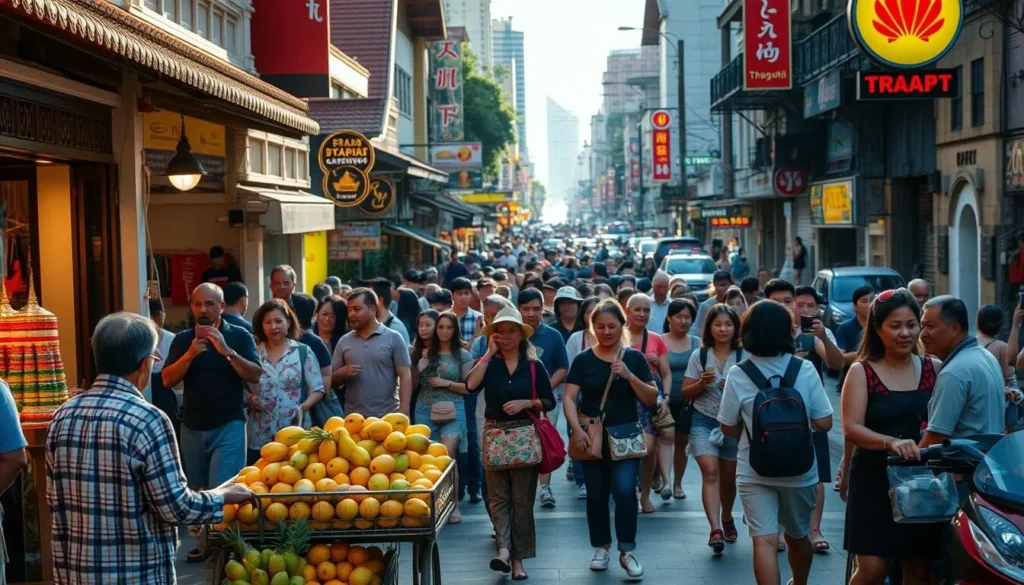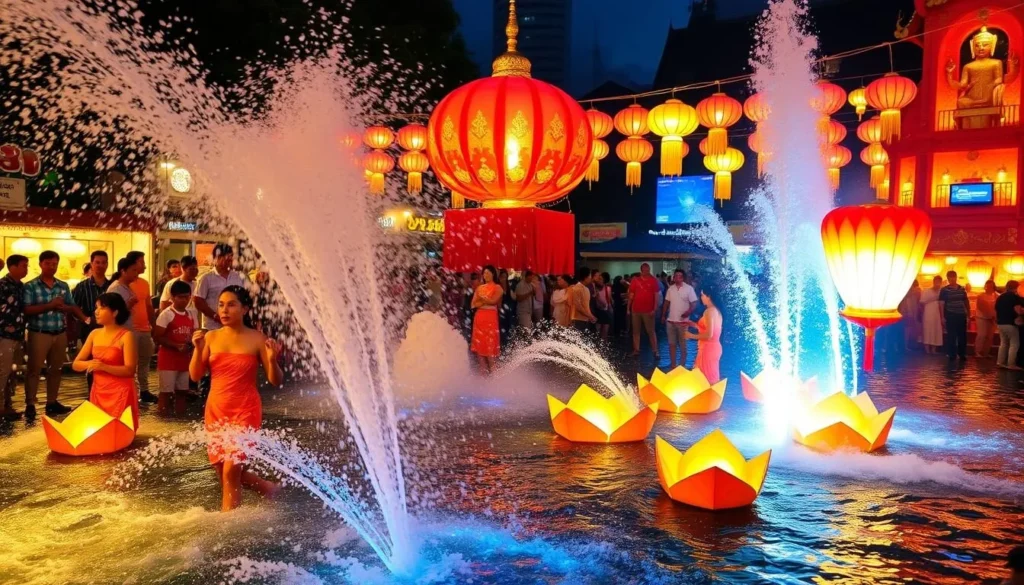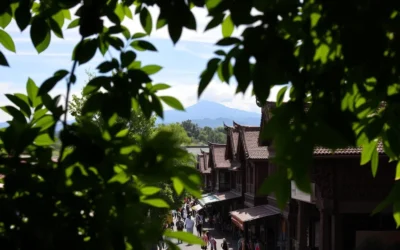Did you know that the weather in Bangkok can significantly impact your travel experience? With its tropical climate, the city experiences three distinct seasons throughout the year, each offering unique advantages and challenges for travelers.
Planning a trip to this vibrant city requires understanding its weather patterns to ensure you have the best time possible. The timing of your visit can dramatically affect comfort levels, sightseeing opportunities, and even hotel prices.
By understanding Bangkok’s climate, you can make an informed decision about when to visit, ensuring a more enjoyable and stress-free travel experience.
Understanding Bangkok’s Tropical Climate
The tropical climate in Bangkok is a defining feature of the city, with three distinct seasons that offer varying experiences for visitors. Understanding these seasons is crucial for planning a weather-savvy trip.
Bangkok’s Three Distinct Seasons
Bangkok’s climate is characterized by year-round warmth, with three main seasons: cool, hot, and rainy. The cool season (November to February) is the most comfortable time, with temperatures ranging from 25°C to 32°C (77°F to 90°F) and lower humidity. The hot season (March to May) brings intense heat, often exceeding 35°C (95°F), while the rainy season (June to October) features regular afternoon downpours and increased humidity.
How Monsoons Affect Bangkok’s Weather Patterns
Monssoons play a significant role in shaping Bangkok’s weather. The southwest monsoon brings rain from May to October, while the northeast monsoon brings cooler, drier air from November to February. This monsoon cycle significantly influences the city’s weather patterns, with the rainy season receiving over 80% of the annual rainfall.
Average Temperatures and Rainfall Throughout the Year
To better understand Bangkok’s climate, let’s examine the average temperatures and rainfall throughout the year:
| Season | Months | Average Temperature (°C) | Average Rainfall (mm) |
|---|---|---|---|
| Cool | Nov – Feb | 25-32 | 20-50 |
| Hot | Mar – May | 35+ | 100-150 |
| Rainy | Jun – Oct | 26-34 | 200-300 |

By understanding these climate patterns, you can better plan your trip to Bangkok and make the most of your time in this vibrant city.
The Cool Season: November to February
As the calendar flips to November, Bangkok transforms into a traveler’s paradise, offering a respite from the sweltering heat of the preceding months. This period, known as the cool season, is characterized by pleasant temperatures, lower humidity, and minimal rainfall, making it an ideal time to explore the city’s outdoor attractions.
Temperature Ranges and Weather Conditions
During these months, daytime temperatures typically range from 25°C to 30°C (77°F to 86°F), with pleasant evening temperatures that can dip to around 20°C (68°F). This comfortable temperature range makes outdoor exploration enjoyable throughout the day. You can enjoy sightseeing without dripping sweat while walking through temples, and the pleasant evenings are perfect for strolling around Sukhumvit or enjoying rooftop bars.

Humidity Levels and Comfort Factor
The cool season brings a significant drop in humidity levels, hovering between 60-70% compared to the 80-90% experienced during other times of the year. This creates a much more comfortable environment for sightseeing, allowing you to explore Bangkok’s numerous outdoor attractions without the discomfort of excessive heat or humidity.
Rainfall Expectations During These Months
Rainfall is minimal during the cool season, with December and January often experiencing less than 10mm of rain total. This means your outdoor plans are rarely disrupted by weather. November may occasionally experience some lingering showers as it transitions from the rainy season, while February begins to warm up as it approaches the hot season.
| Month | Average Temperature (°C) | Average Rainfall (mm) | Humidity Level (%) |
|---|---|---|---|
| November | 28 | 50 | 65 |
| December | 27 | 10 | 60 |
| January | 26 | 5 | 60 |
| February | 28 | 20 | 65 |
The clear skies and lower humidity during the cool season create ideal conditions for photography and visiting Bangkok’s numerous outdoor attractions like the Grand Palace, Wat Arun, and the city’s famous markets. This is indeed the best time to visit Thailand, especially Bangkok, as the weather conditions are perfect for a wide range of activities.
The Hot Season: March to May
Stepping into Bangkok during the hot season is like entering a sauna, with dry, intense heat that can be overwhelming. You’re in for a treat if you can handle the temperatures, as this period offers unique experiences and advantages.
Peak Temperature Periods and Heat Indexes
The hot season in Bangkok brings extreme temperatures that regularly exceed 35°C (95°F) and can occasionally reach 40°C (104°F). April is typically the hottest month, with heat indexes often reaching into the mid-40s°C (110°F+) due to the combination of heat and humidity. This can be challenging for unprepared travelers, so it’s essential to plan accordingly.

Managing Bangkok’s Intense Heat
To make the most of your visit, strategic planning is key. Schedule your outdoor activities for early morning (before 10 am) or evening (after 4 pm) to avoid the peak heat. Stay hydrated, wear lightweight clothing, and plan midday breaks in air-conditioned spaces like Bangkok’s world-class shopping malls, such as IconSiam.
Songkran Festival and Other Hot Season Events
Despite the intense heat, the hot season offers several advantages, including fewer tourists compared to peak season, lower hotel rates, and the opportunity to experience one of Thailand’s most famous cultural events: the Songkran water festival. Held from April 13-15, Songkran transforms Bangkok into a massive water fight, providing welcome relief from the heat and a unique cultural experience.
The hot season is ideal for water-based activities and exploring the city’s indoor attractions like museums and art galleries. You’ll also find that many locals adjust their schedules to avoid the heat, making early morning visits to temples and markets particularly rewarding as you experience these places alongside Bangkok residents.
The Rainy Season: June to October
Bangkok’s rainy season, spanning from June to October, brings with it a unique charm. The monsoon rains transform the city into a lush, green oasis, offering a refreshing change from the usual dry landscape.

Monsoon Patterns and Flooding Risks
The rainy season in Bangkok is characterized by regular afternoon downpours rather than constant rainfall. Most mornings start clear, with clouds building throughout the day, leading to heavy but brief thunderstorms between 2-5 pm. September is statistically the wettest month, receiving an average of 344 mm of rainfall. While flooding can occur in certain areas, particularly in low-lying neighborhoods and areas near canals, the city’s main tourist districts and newer areas have improved drainage systems to mitigate this risk.
Daily Rain Patterns and Planning Around Showers
Understanding the typical rain patterns can help you plan your day. Mornings are usually dry, making them ideal for outdoor activities. As the day progresses, clouds build up, and heavy showers become more likely. By evening, the rain often clears, allowing for a pleasant dinner out or a stroll along the river.
Humidity Levels and Comfort Considerations
During the rainy season, humidity levels in Bangkok typically range from 75-90%, creating a sticky, tropical feeling. This high humidity can make the temperatures feel much hotter than they actually are, with perceived temperatures often exceeding 30-32°C (86-90°F). However, the rain also brings a welcome drop in temperature, providing some relief from the heat.
The advantages of visiting during the rainy season include substantially lower hotel rates, often 30-50% less than peak season, and fewer tourists at major attractions. The city’s parks and gardens become particularly lush and green, offering unique photography opportunities. Additionally, the dramatic skies and clearer air quality after rainfall make for a more authentic experience of daily life in Bangkok.
By understanding the characteristics of Bangkok’s rainy season, you can better plan your trip and make the most of your time in this vibrant city.
Bangkok, Thailand: Best Months for a Weather-Savvy Trip
The ideal time to visit Bangkok depends on your preferences, whether you’re looking for pleasant weather, cultural festivals, or budget-friendly options. Bangkok is always a good idea, but finding the right time that suits your style can make your trip even more enjoyable.
November to February: The Ideal Weather Window
For the best weather and sightseeing, the months between November and February are ideal. During this period, temperatures are moderate, ranging from 25-30°C (77-86°F), humidity is relatively lower, and rainfall is minimal. This creates perfect conditions for extensive sightseeing and outdoor activities.
- December and January are the peak months with the best weather but also the highest tourist numbers and prices.
- November and February offer nearly identical weather conditions with slightly fewer crowds and better rates.

Shoulder Season Options: October and March
The shoulder seasons, October and March, provide excellent compromises for weather-conscious travelers. October sees decreasing rainfall as the monsoon retreats, while March offers warm but not yet scorching temperatures before April’s extreme heat.
Weather-Based Recommendations for Different Travelers
Different types of travelers should consider different timing for their visit:
- First-time visitors should prioritize the November-February window for the best experience.
- Budget travelers might prefer June-September for the lowest prices.
- Festival enthusiasts should target April for Songkran or November for Loy Krathong.
- Photography enthusiasts might find the late rainy season (September-October) ideal for capturing dramatic skies and lush greenery.
- Families with children typically find December-January most comfortable.
- Business travelers with flexible schedules can find significant savings by visiting during the rainy season.
At the end of the day, Bangkok is always a good idea—it’s just about finding the right time that suits your style.
Tourist Crowds and Pricing by Season
When planning your trip to Bangkok, understanding the dynamics of tourist crowds and pricing can significantly enhance your travel experience. The city’s tourist season is closely tied to its weather conditions, which in turn affect how crowded popular spots are and how much you’ll pay for accommodations and flights.
Peak Tourist Season: When to Expect Crowds
Bangkok’s peak tourist season aligns with its cool and dry weather, typically from November through February. This period, especially around Christmas and New Year’s, sees hotel occupancy rates often exceeding 90%. Popular attractions like the Grand Palace, Wat Pho, and Chatuchak Weekend Market are at their busiest between 10 am and 2 pm.
Expect to pay 30-50% more for accommodations during peak season compared to the low season rates. Luxury hotels may even double their prices for the December-January period. It’s advisable to book your flights and hotels well in advance to secure better rates.
Low Season Advantages: Better Deals and Fewer Tourists
The low season, which spans from June to September, offers several advantages for budget-conscious travelers. Luxury hotels often reduce their rates to mid-range levels, and wait times at popular attractions significantly decrease. While the weather is hotter and rainier, the savings and fewer crowds can make for a more relaxed experience.
- Luxury hotels at mid-range prices
- Reduced wait times at attractions
- Potential for better flight deals
How Weather Affects Hotel and Flight Pricing
Weather directly impacts pricing through supply and demand. Hotels and airlines adjust their rates based on historical booking patterns that follow weather conditions. The shoulder seasons, October and March, offer a good compromise between favorable weather and reasonable pricing, with hotel rates typically 15-25% lower than during peak season.
| Season | Weather | Crowd Level | Prices |
|---|---|---|---|
| Peak (Nov-Feb) | Cool & Dry | High | High |
| Low (Jun-Sep) | Hot & Rainy | Low | Low |
| Shoulder (Oct & Mar) | Mild | Moderate | Moderate |

Best Outdoor Activities Based on Bangkok’s Weather

Understanding Bangkok’s weather patterns is crucial to making the most of your outdoor experiences. The city’s climate varies significantly throughout the year, impacting the types of activities you can enjoy.
Cool Season: Temple Tours and Market Exploration
During the cool season (November to February), Bangkok’s weather is ideal for outdoor activities. You can explore the city’s famous temples, such as the Grand Palace, Wat Arun, and Wat Pho, without the discomfort of excessive heat.
Early morning temple visits (7-9 am) offer comfortable temperatures and smaller crowds, making it an ideal time to explore these legendary sites.
The cool season is also perfect for visiting Chatuchak Weekend Market, where you can shop comfortably without sweating through your clothes.
Hot Season: Water-Based Activities and Indoor Attractions
As the temperature rises during the hot season (March to May), it’s essential to plan your activities strategically. Water-based experiences like canal tours, river cruises, and visits to water parks become particularly appealing.
During the hottest months, Bangkok’s indoor attractions gain popularity, including world-class shopping malls like Siam Paragon and IconSiam, cultural museums like the Jim Thompson House, and culinary experiences in air-conditioned settings.
Rainy Season: Covered Markets and Cultural Experiences
Visitors during the rainy season should prioritize Bangkok’s covered attractions like Chatuchak Weekend Market (which is partially covered) and the Train Night Market Ratchada.
Bangkok’s evening activities, including rooftop bars, night markets, and dinner cruises, become particularly appealing during the rainy season when afternoons may be wet but evenings often clear up.
Regardless of the season, Bangkok’s extensive public transportation system provides weather-protected ways to navigate the city, making it possible to enjoy the city even during inclement weather.
Packing Essentials for Bangkok’s Different Seasons
Packing for Bangkok requires consideration of the city’s three distinct seasons: cool, hot, and rainy. Understanding these seasons is key to a comfortable and enjoyable trip.
Essentials for the Cool Season
For Bangkok’s cool season, from November to February, pack lightweight clothing but include at least one light sweater or jacket for cooler evenings, especially if you plan to visit rooftop bars or take evening river cruises. Modest clothing that covers shoulders and knees is also a must when visiting temples.
Must-Haves for the Hot Season
During the hot season, from March to May, moisture-wicking fabrics, a wide-brimmed hat, high-SPF sunscreen, UV-blocking sunglasses, a reusable water bottle, and cooling towels or portable fans are essential to combat the intense heat.
Gear and Clothing for the Rainy Season
For the rainy season, from June to October, quick-drying synthetic fabrics are a must. Avoid cotton, which stays wet and heavy. A compact, sturdy umbrella is also indispensable. Waterproof sandals or water-resistant shoes can prevent the discomfort of soggy feet after showers.

Regardless of the season, packing a day bag with essentials like water, sunscreen, and temple-appropriate clothing is recommended. Bangkok’s variable weather and strict dress codes at certain attractions may require quick adjustments to your outfit.
Day Trips from Bangkok: Weather Considerations

To make the most of your day trips from Bangkok, consider the weather first. Bangkok’s proximity to various attractions makes it an ideal base for exploring different environments, from ancient ruins to beach destinations.
Ayutthaya and Floating Markets: When to Go
The ancient city of Ayutthaya, a UNESCO World Heritage site, is best visited during the cool season (November-February) when comfortable temperatures allow for extensive exploration of the temple ruins without overheating. Floating markets like Damnoen Saduak and Amphawa are weather-dependent experiences that are most enjoyable during the dry season. Visiting early in the morning (6-9 am) is recommended to avoid both afternoon heat and potential rain.
Beach Excursions: Seasonal Recommendations
Beach excursions from Bangkok to destinations like Hua Hin or Pattaya are best planned during the November-April period when seas are calmer and rainfall is minimal. This timing ensures a more enjoyable and relaxing beach experience.
Indoor Alternatives for Rainy Days
During the rainy season (June-October), day trips require flexible planning. Monitor weather forecasts and consider having backup indoor options ready, such as Thai cooking classes or visits to Bangkok’s museums. The Bang Pa-In Summer Palace near Ayutthaya offers a good balance of indoor and outdoor spaces, making it a suitable day trip option during transitional months.
Bangkok’s Festivals and Weather Connections

Bangkok’s festivals are closely tied to its weather patterns, making the city’s cultural calendar a fascinating reflection of its climate. Many of Bangkok’s celebrations are strategically scheduled during the most appropriate seasons for their activities.
Weather-Dependent Celebrations
Some of Bangkok’s most notable festivals are directly influenced by the weather. For example, the Songkran Festival (April 13-15) coincides with the peak of the hot season, transforming the discomfort of extreme heat into a joyous nationwide water festival. This festival provides welcome relief from temperatures that often exceed 35°C (95°F).
Indoor Festivals and Cultural Events
During the rainy season, Bangkok offers a range of indoor cultural events and performances at venues like the Thailand Cultural Center and various Bangkok theaters. These events provide excellent entertainment options when outdoor activities might be limited by afternoon showers.
Planning Your Trip Around Major Festivals
When planning a trip to Bangkok around major festivals like Loy Krathong (November) or Chinese New Year (January/February), consider booking accommodations well in advance (3-6 months) as hotels often reach full capacity and increase rates significantly during popular celebrations.
Understanding the connection between Bangkok’s festivals and its weather can enhance your travel experience, allowing you to participate in the city’s vibrant cultural events at the right time.
Special Considerations for Photography and Sightseeing
Bangkok’s diverse weather conditions present both challenges and opportunities for photographers and sightseers alike. Understanding these conditions can help you make the most of your visit.
Best Light Conditions by Season
The cool season, from November to February, offers the most consistent light conditions, with clear skies providing excellent golden hour opportunities during early morning and late afternoon. In contrast, the hot season’s intense midday sun can create harsh lighting, making early morning photography ideal. The rainy season brings unique opportunities with dramatic storm clouds and reflections in puddles.
| Season | Best Time for Photography | Notable Features |
|---|---|---|
| Cool Season (Nov-Feb) | Early morning, late afternoon | Golden hour, clear skies |
| Hot Season (Mar-May) | Early morning | Harsh midday sun, vibrant street life |
| Rainy Season (Jun-Oct) | After rain showers | Dramatic storm clouds, reflections |
Protecting Camera Equipment in Different Weather
To protect your camera equipment, consider using weather-sealed cameras and lenses, especially during the rainy season. Additional accessories like rain covers, silica gel packets, and waterproof bags can also be essential.
Weather-Related Photography Opportunities
Bangkok offers a range of photography opportunities tied to its weather conditions. Capture the sunset from Wat Arun during the cool season, document Songkran water festivities during the hot season, or photograph dramatic monsoon skies over the Grand Palace during the rainy season.
By understanding and adapting to Bangkok’s weather, you can enhance your photography experience and capture the city’s unique beauty.
Conclusion: Making the Most of Bangkok’s Weather
The key to enjoying Bangkok lies in understanding its tropical climate and planning accordingly. Bangkok offers rewarding experiences year-round, but being aware of its weather patterns allows you to align your visit with your personal preferences and travel priorities.
Flexibility is crucial when traveling to Bangkok. The cool season (November-February) is ideal for first-time visitors and those who prioritize comfortable sightseeing, but it comes with peak crowds and prices. On the other hand, the rainy season (June-October) offers significant discounts, with hotels reducing rates by 30-50% and fewer tourists at major attractions.
To make the most of your trip, consider scheduling outdoor activities in the morning and having indoor alternatives ready for rainy afternoons. Each season has its unique advantages: the cool months offer pristine weather, the hot season is perfect for cultural festivals, and the rainy period brings lush landscapes and budget-friendly pricing.
Ultimately, the best time to visit Bangkok depends on your priorities. Whether you value perfect weather, cultural experiences, or budget considerations, Bangkok is a vibrant destination that can cater to your needs. With the right mindset and planning, you can have an amazing trip to Bangkok, regardless of when you visit.
For the best weather & sightseeing, consider visiting between November and February ☀️. For a cultural experience and festivals, March to May is ideal 🎉. If you’re on a budget, look for deals between June and October 💰.
—
The above is subject to change.
Check back often to TRAVEL.COM for the latest travel tips and deals.






